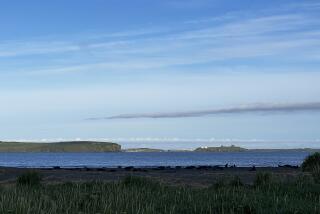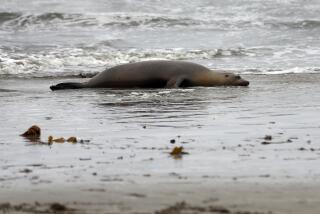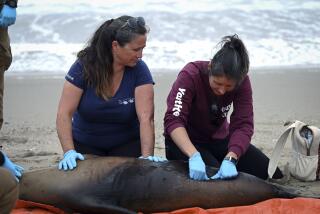Protection for Foxes Sought
Biologists at the Channel Islands are carrying the survival of a species on their shoulders.
Picked off by golden eagles and ravaged by disease and the continuing effect of humans, the population of island foxes on the six largest islands has fallen from 6,000 to fewer than 2,000 in the last couple of years.
And the scientists whose job it is to save them are feeling the pressure. “Island foxes have been out here for 20,000 years,” said Tim Coonan, a Channel Islands National Park Service biologist. “I don’t want to lose them this year.”
But news Wednesday that the island fox is one of eight species proposed for the federal endangered species list may make Coonan’s job easier. It could mean a higher profile, more protection, and--most important--more money.
“I feel a bit naked and vulnerable without the benefit of the Endangered Species Act,” Coonan said. “I’m pretty jazzed about this. It means full steam ahead.”
The island fox population plummeted 90% in four years on the three northern Channel Islands run by the national park system that have foxes: San Miguel, Santa Rosa and Santa Cruz. On Santa Cruz, biologists are racing against an October deadline to remove a nonnative predator--the golden eagle--that could otherwise require them to take the remaining foxes into captivity.
On southern Santa Catalina Island, where humans and their pets have mostly free rein, canine distemper killed off legions of the species.
The proposal is not a guarantee that the six subspecies of island fox--one for each island with a fox population, and each one facing its own challenges--will earn endangered status. But biologists are confident, particularly with its already well-documented decline, that the fox is a shoo-in.
Placement on the endangered species list would require an islands-wide recovery plan. That would require more cooperation among the various agencies that handle the fox in the Channel Islands.
At the same time, the listing could mean more paperwork and complications for the Navy, in particular. It owns San Nicolas and part of San Clemente islands, the only two where the fox is thriving.
On San Clemente Island, the Navy is spending $2.5 million annually to protect 42 endangered loggerhead shrike in the wild and 64 of the birds in a captive breeding program. Several years ago, the Navy had to kill the foxes that were feeding on the shrikes.
The Navy issued a statement Wednesday saying it would continue to work with the U.S. Fish and Wildlife Service, but it declined to speculate on the effect of the foxes’ listing on efforts to protect the shrike.
But at a recent meeting of fox experts, biologists said they believe that trapping efforts there may be affecting the fox population, which now numbers about 500 to 600. Even so, “there’s not a lot I can see that the Navy is doing wrong,” said Dave Garcelon, a wildlife biologist who has worked on San Clemente.
Foxes Descended From Mainland Species
But Garcelon said he isn’t sure how much difference the listing will make.
“I think there’s already been a tremendous effort put forward,” he said. “It’s in many ways unprecedented for a species that hasn’t been listed.”
Foxes have one advantage over other rare species: they have the fuzzy, innocent faces that end up on posters and TV shows.
“It’s a lot easier than raising money for white abalone,” Coonan said.
About the size of cats, the foxes are descendants of mainland foxes that have grown smaller over generations on the isolated Channel Islands.
Artifacts from Chumash graves reveal that on some islands the foxes were kept as pets and were buried with their masters. They have long been protected from predators by the ocean barrier, and so have little fear of humans or predators.
On San Miguel, there are 32 foxes in captivity; one fox remains in the wild. On Santa Rosa Island, where captive breeding began last year, there are 22 foxes in captivity, including eight pups born last year.
The National Park Service is working to remove golden eagles, along with the feral pigs that have drawn them to the islands. Only then will biologists be able to release the foxes into a less dangerous home.
Scientists like to avoid captive breeding programs. They are expensive--about $250,000 a year at the national parks--and stressful to foxes. But it is increasingly seen as necessary.
“It’s tough on the animals and tough on the resources,” said Paul Collins, curator of vertebrate zoology at the Santa Barbara Museum of Natural History. But, sometimes “there are no other options out there.”
On San Miguel, some foxes clung to the roofs when first caged. Catalina, where scientists are also running a captive-breeding program, lost a large number of pups this year.
Biologists suspect that is because some females were pregnant when they were captured. Meanwhile, they have created a distemper vaccine for the foxes on Catalina--about 80% to 90% of the population there has received it.
That kind of learning helps future programs, such as the likely one on Santa Cruz Island.
“What’s really nice is that everyone working on island fox is communicating,” said Peter Schuyler, the Santa Catalina Island Conservancy’s director of ecological conservation.
“There’s a mutual back-and-forth.”
Humans Biggest Threat on San Nicolas Island
Golden eagles don’t venture to the Navy’s remote San Nicolas Island, where about 250 people live, work and share the island with 400 foxes.
So humans, and their cars, are the biggest threat.
Biologists have locked dumpsters and reduced the speed limit from 45 to 35 mph.
The island’s roads are dotted with fox-crossing signs.
No mainland dogs are brought onto the island, and officials discourage feeding the foxes or treating them as pets.
“It’s people management versus animal management,” said biologist Grace Smith.
But even there, biologists say, the fox population is walking a thin line of survival. An outbreak of canine distemper in the 1970s thinned the population, leaving very little genetic diversity.
More to Read
Sign up for Essential California
The most important California stories and recommendations in your inbox every morning.
You may occasionally receive promotional content from the Los Angeles Times.










